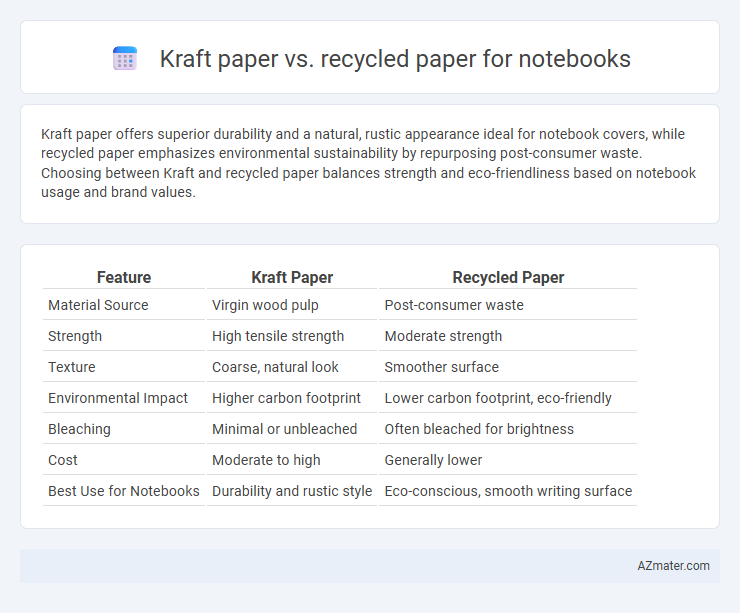Kraft paper offers superior durability and a natural, rustic appearance ideal for notebook covers, while recycled paper emphasizes environmental sustainability by repurposing post-consumer waste. Choosing between Kraft and recycled paper balances strength and eco-friendliness based on notebook usage and brand values.
Table of Comparison
| Feature | Kraft Paper | Recycled Paper |
|---|---|---|
| Material Source | Virgin wood pulp | Post-consumer waste |
| Strength | High tensile strength | Moderate strength |
| Texture | Coarse, natural look | Smoother surface |
| Environmental Impact | Higher carbon footprint | Lower carbon footprint, eco-friendly |
| Bleaching | Minimal or unbleached | Often bleached for brightness |
| Cost | Moderate to high | Generally lower |
| Best Use for Notebooks | Durability and rustic style | Eco-conscious, smooth writing surface |
Overview: Understanding Kraft Paper and Recycled Paper
Kraft paper is a durable, coarse-textured material made from chemical pulp during the kraft process, known for its high strength and natural brown color, making it ideal for notebook covers that require resilience. Recycled paper consists of fibers reclaimed from used paper products, offering an eco-friendly alternative by reducing waste and conserving resources while maintaining adequate quality for notebook pages. Both materials contribute to sustainability, but kraft paper emphasizes durability and raw aesthetics, whereas recycled paper prioritizes environmental impact through fiber reuse.
Material Composition and Sourcing
Kraft paper, made from wood pulp through a chemical kraft process, offers a strong and durable material ideal for notebook covers and pages, sourced mainly from virgin fibers harvested from sustainably managed forests. Recycled paper, produced from recovered fibers including post-consumer and post-industrial waste, emphasizes environmental benefits by reducing deforestation and energy consumption but may have slightly lower fiber strength due to fiber shortening during recycling. The choice between kraft and recycled paper for notebooks hinges on balancing material robustness with ecological impact, with sourcing transparency playing a crucial role in sustainable paper product development.
Environmental Impact Comparison
Kraft paper for notebooks offers strong durability with a relatively low environmental footprint due to its minimal processing and biodegradability. Recycled paper significantly reduces landfill waste and conserves natural resources by reusing fibers, but its production may involve chemicals and energy-intensive processes that impact the environment. Choosing between kraft and recycled paper requires balancing durability, resource conservation, and overall carbon emissions in notebook manufacturing.
Durability and Strength Considerations
Kraft paper offers superior durability and strength for notebooks due to its long fibers and minimal chemical processing, resulting in better tear resistance and weight-bearing capacity compared to recycled paper. Recycled paper, while environmentally friendly, often contains shorter fibers that reduce its tensile strength and make it more prone to wear and damage over time. Notebooks made with kraft paper are ideal for heavy-duty use and long-lasting performance, whereas recycled paper suits lighter, eco-conscious applications.
Aesthetic and Texture Differences
Kraft paper features a natural brown hue with visible fibers, providing a rustic, organic aesthetic preferred for vintage or eco-friendly notebook designs. Recycled paper usually has a lighter, often off-white tone with a smoother surface, offering a cleaner, modern look that appeals to eco-conscious users valuing sustainability. Texture-wise, kraft paper presents a rougher, coarser feel enhancing grip and tactile engagement, while recycled paper tends to be softer and more uniform, ensuring a smoother writing experience.
Writing Experience and Paper Performance
Kraft paper offers a smooth, durable surface with a natural texture that enhances pen grip and reduces ink bleed-through, ideal for various writing instruments. Recycled paper, while eco-friendly, often has a rougher texture and may contain fibers that can cause inconsistent ink absorption and occasional smudging. Notebooks made with kraft paper generally provide a more reliable and comfortable writing experience, especially for users prioritizing paper strength and longevity.
Cost Implications for Notebooks
Kraft paper for notebooks generally incurs higher costs due to its durability and thicker texture, making it suitable for premium products. Recycled paper offers a cost-effective alternative by utilizing post-consumer waste, significantly reducing raw material expenses and waste management fees. The choice between kraft and recycled paper impacts the overall notebook pricing, balancing quality demands with budget constraints in production.
Popular Uses in Notebook Manufacturing
Kraft paper is widely favored in notebook manufacturing for its high durability and natural brown appearance, making it ideal for covers and eco-friendly designs. Recycled paper is predominantly used for inner pages due to its sustainable attributes and smooth writing surface, appealing to environmentally conscious consumers. Both materials support eco-friendly notebook production, with kraft paper emphasizing strength and recycled paper highlighting sustainability.
Consumer Preferences and Market Trends
Consumers increasingly prefer Kraft paper for notebooks due to its durability, natural texture, and eco-friendly appeal, which align with growing sustainability trends. Market data shows that Kraft paper notebooks dominate the premium segment, favored for artisanal and rustic aesthetics, while recycled paper notebooks attract environmentally conscious buyers seeking affordability and reduced carbon footprint. Sales analytics reveal a steady rise in demand for recycled paper notebooks driven by corporate social responsibility initiatives and green product certifications.
Choosing the Best Option for Your Notebook
Kraft paper offers durability and a natural, rustic look, making it ideal for notebooks that require strong covers or sturdy pages. Recycled paper provides an eco-friendly choice by reducing waste and conserving resources, often suited for interior pages or environmentally conscious brands. Choosing the best option depends on prioritizing either durability and aesthetics with kraft paper or sustainability and reduced environmental impact with recycled paper.

Infographic: Kraft paper vs Recycled paper for Notebook
 azmater.com
azmater.com